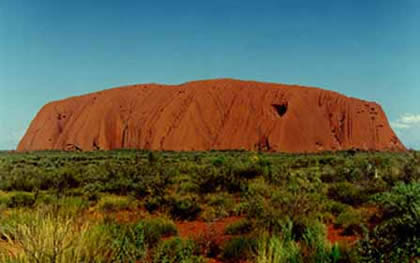文化講座
Uluru:Ayers Rock (ウルル エアーズロック)

今月はオーストラリアの砂漠の真ん中にある巨大な岩、ウルルを訪れてみましょう。長い地球の歴史から誕生したウルルは観光のハイライトであり、毎年多くの観光客が訪れこの岩を登ります。しかし、この土地に長く住むアボリジニーの人々にとって、ウルルは神聖な岩であり、聖霊のが宿ると信じられています。まず、ウルルを説明する内容をみましょう。(観光ガイドブックからの抜粋)
Uluru (also known as Ayers Rock) is a large sandstone rock formation in central Australia, in the Northern territory. It is located in Uluru-kata Tjuta National Park, 350 km southwest of Alice Springs. It is the second largest monolith in the world (after Mount Augustus, also in Australia), more than 318 m high and 8 km around. It also extends 2.5 km into the ground. It was described by explorer Ernest Giles in 1872 as 'the remarkable pebble.'
(ウルル「又の名をエアーズロック」は中央オーストラリア、ノーザンテリトリーにある巨大な岩石で、アリススプリングスの南東350kmにあるウルルカタジュタ内に位置しています。これは世界で2番目に大きな一枚岩(同じくオーストラリアにあるオーガスタ山に次ぐ)で、標高318m、周囲8kmに及びます。また、地下2.5kmに延び1872年に探検家アーネストガイルズはこの岩を「まれに見る石」と評しています。)
今回、中日文子はUluru Ayers Rockでガイドのジムにいろいろたずねています。会話を見てみましょう。
| Dialog 1 (Fumiko is asking Jim, a local guide about Uluru.) | |
| Fumiko: | How was Uluru or Ayers Rock made? |
| Jim: | Uluru is an ' island mountain' which was left as an isolated remnant after the slow erosion of an original mountain range. |
| Fumiko: | Is it one piece of rock? |
| Jim: | It is referred to as a monolith which means one solid mass of rock. But geologists don't use the word 'monolith' because the word has many different meanings. |
| Fumiko: | How come this rock remained while the other surrounding rocks turned into soil? |
| Jim: | This rock is homogeneous and doesn't have jointing and parting at bedding surfaces. |
| 会話 1 (文子はローカルガイドのジムにウルルについて質問しています。) | |
| 文子: | ウルルすなわちエアーズロックはどういうふうに作られたのですか? |
| ジム: | ウルルは「山の島」で、もともと山だったのがゆっくりと侵食されて孤立して残ったのです。 |
| 文子: | それは一枚岩なのですか? |
| ジム: | 一枚岩と言われていますが、つまり、一つの大きな岩の固まりです。 でも地質学者は'monolith'と言いません。というのはその言葉はいろいろな意味があるからです。 |
| 文子: | なぜ周りの岩は土になってしまったのにこの岩は残ったのですか? |
| ジム: | この岩は同質性で底の表面に継ぎ目や割れ目がないのです。 |
更に会話は続きます。
| Dialog 2 (Fumiko is now asking about history of Uluru) | |
| Fumiko: | Can you tell me about history of Uluru? |
| Jim: |
It is believed that humans settled in the area more than 10,000 years ago. Europeans arrived in the Australian Western Desert in the 1870s. Uluru and Kata Tjuta were first mapped by Europeans in 1872 during the expeditionary peiod made possible by the construction of Australian Telegraph Line. In separate expedition, Ernst Giles and William Gosse explored this area for the first time as Europeans. While exploring the area in 1872, Giles sighted Kata Tjuta and called it Mount Olga, while the following year Gosse observed Uluru and named it Ayers Rock. Later white Europeans and natives called Anangu began interaction and competition between them became frequent and violent. Between 1918 and 1921, large adjoining areas of South Australia, Western Australia and Northern Territory were declared as aboriginal reserves, sanctuaries for nomadic people who had had virtually no contact with European settlers. In 1920, part of Uluru-KataTjuta National Park was declared an Aboriginal Reserve by the Australian government. |
| 会話 2 (文子はウルルの歴史についてきいています。) | |
| 文子: | ウルルの歴史について教えてください。 |
| ジム: | 人類はこの地方に10000年前に住み着いたと思われています。1870年代にヨーロッパ人がオーストラリア西砂漠にやってきました。ウルルカタジュタは1872年、オーストラリア電報ラインの建設によって可能になった遠征時代に地図に載るようになりました。また別の探検でアーネストガイルズとウィリアムゴッスがヨーロッパ人として初めてこの地域を探検しました。1872年にガイルズはカタジュタを見てオルガ山と呼び、翌年ゴッスはウルルをエアーズロックと名をつけました。後にヨーロッパ白人と土着民のアナングは交易を始め両者の競争は頻繁になり、激しくもなりました。1918年~1921年に隣接する南オーストラリア、西オーストラリアそしてノーザンテリトリーの広大な地域がアボリジニー居留区に指定され、ヨーロッパの移民と事実上接触のなかった遊牧民の保護区としました。1920年にウルルーカタジュタの一部がオーストラリア政府によってアボリジニー指定地区になりました。 |
(語句)
1.monolith 一枚岩 mono-は一つを表すギリシア語。
2.isolated remnant 孤立して残ったもの。 islandも同じ語源。
3.erosion 侵食。動詞はerode
4.expeditionary period ヨーロッパ人によるオーストラリアの開拓時代。
5.interaction かかわり会い。動詞interact 形容詞interactiveも憶えましょう。
6.reserve 指定地区 sanctuary 保護地区
7.nomadic 遊牧(民)の(形容詞) nomad(名詞)もいっしょに憶えよう。
8.Aborigine オーストラリア先住民 Aboriginal (形容詞) も一緒に憶えましょう。
オーストラリアの世界遺産の一つであるウルル(エアーズロック)は先住民アボリジニーにとって神聖な場所であります。彼らの文化に対する尊敬を持ちましょう。(Respect the local people's culture.)ロックに登る時にもそこに住む神を汚さないように気をつけましょう。風が強い時には怪我をすることもありますので十分ご注意を。
ご意見、ご質問をお待ちします。 expectation77@katch.ne.jp
中日文化センター講師 瀬戸勝幸
(スパムメール対策のため@は大文字を使っています。メールを送る際は@を小文字にしてお送りください。)

